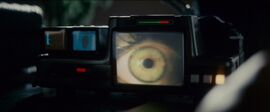|
| |||||

The Voight-Kampff test was a test used as of 2019 by the LAPD's Blade Runners to assist in the testing of an individual to see whether they were a replicant or not. It measured bodily functions such as respiration, heart rate, blushing and eye movement in response to emotionally provocative questions. It typically took twenty to thirty cross-referenced questions to distinguish a replicant.[1]
History
In November 2019, the test was conducted by Dave Holden on the replicant Leon Kowalski, who suddenly became violent during questioning and shot Holden.[1]
Later that month, Rick Deckard was ordered to perform the test at the Tyrell Corporation on the Nexus-7,[2] Rachael. With her test, it took over one-hundred questions to determine her nature. The reason for this was told to Deckard by Eldon Tyrell, who stated that Rachael was an experimental replicant.[1]
Rachael later asked Deckard if he had passed the Voight-Kampff test, but did not receive an answer, as he was asleep.[1]
Behind the scenes
The test originally appears in Philip K. Dick's Do Androids Dream of Electric Sheep?, where it is spelled "Voigt-Kampff."
Description from the original 1982 Blade Runner presskit:
- A very advanced form of lie detector that measures contractions of the iris muscle and the presence of invisible airborne particles emitted from the body. The bellows were designed for the latter function and give the machine the menacing air of a sinister insect. The VK is used primarily by Blade Runners to determine if a suspect is truly human by measuring the degree of his empathic response through carefully worded questions and statements.
The Voight-Kampff machine is perhaps analogous to (and may have been partly inspired by) Alan Turing's work which propounded an artificial intelligence test — to see if a computer could convince a human (by answering set questions, etc.) that it was another human. The phrase Turing test was popularised by science fiction but was not used until years after Turing's death.
See also
References
External links
- Voight-Kampff entry - Official Blade Runner online magazine
- Excerpt describing the machine from "Do Androids Dream of Electric Sheep?"
| |||||||||||||||||||||||||||||||||||||||||
